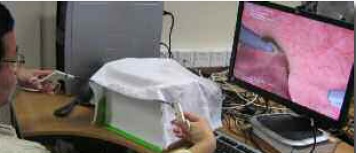➣ ByJun J. Pan et al.

Figure 1: VR simulator in laparoscopic rectum surgery.
The last two decades have seen some of the most exciting developments in medicine with the advent of minimally invasive surgery (MIS) including both laparoscopic and endoscopic techniques. MIS reduces the surgical trauma to the patient, thereby dampening the surgical stress response. This results in better outcomes with less postoperative pain, a shorter hospital stay and a quicker return to normality.
Colorectal cancer is the third most common cancer in the UK, with approximately 40,000 new cases diagnosed annually. Surgery remains the mainstay of treatment and is the primary intervention in 80% of cases. Although it is estimated that 90% of cases are suitable for a laparoscopic approach, there has been a relative lack of surgeons trained to perform such a demanding surgery. This is particularly true for rectal cancer surgery which is the most complex and technically challenging for the laparoscopic colorectal surgeon. The learning curve of a laparoscopic surgeon can be influenced in a number of ways. Laparoscopic training boxes provide the junior surgeon with training on inanimate objects, but offer only mundane tasks and lack the feel of handling human tissue. Animal tissue can be used but differs in anatomy to humans, and although cadaveric courses are available they are expensive and do not allow repetitive practice. In addition, the tradition of training in animal tissue is particularly criticized and can pose ethical dilemmas. In reality, trainees in many countries, including the UK, develop their laparoscopic skills by operating directly on patients under the supervision of senior surgeons. Recently, with the rapid growth of computer technology and power, Virtual Reality (VR) simulators have become a viable alternative, allowing the trainees to hone their skills by operating on a virtual patient. Compared with traditional surgical training on patients, VR-based methods have the following advantages:
- Repetitive tasks: A VR-based system can be reused many times without risk to patients.
- Variable complexity: Different scenarios can be simulated including extreme situations, allowing the response to be rehearsed.
- Surgeon responses can be recorded: Skills and training progress can be objectively recorded, measured and evaluated.
Our researchers have developed a VR simulation system for laparoscopic surgery on the rectum, perhaps the most challenging surgery encountered by the laparoscopic surgeon. The hardware of our system includes a computer, a display screen and two haptic devices (Phantom Omni). These devices can be used as grasping tools, as well as dissecting instruments or energy sources depending on the function selected, and are interchangeable between the two haptic devices (Figure 1). The haptic device provides 6-DOF navigating parameters (pitch, yaw, insertion) and force feedback when there is a collision detected. The user interface (Figure 2) also permits the user to use the haptic device as a navigation camera. We created the surface mesh model of a rectum and its surrounding tissue using data from a Magnetic Resonance Image (MRI) of the rectum and by referencing real surgery videos, as it is simple and efficient in deformation computation. Run-time operations include soft tissue deformation, collision detection, cutting, rendering and communication with the haptic devices. Some novel techniques are applied in this system. A haptic force filter based on the radial basis functions can adjust the force adaptively according to the mesh density of the contact surface. A Cosserat rod model has been introduced to cope with frequent collision detection and substantial soft tissue deformation. It parameterizes the centerline of the intestine with material coordinates. Rigid spheres are attached to the Cosserat rod, approximating the 3-D shape as bounding volumes of the intestine model. This approach meets the system requirement of realtime graphic performance and high deformation accuracy.
Two consultant surgeons, from hospitals in Bournemouth and Poole, have been closely involved in the development of the system from the outset. They both provide regular input, advising our researchers about the medical aspects of the VR model and help to evaluate the results. The tactile feedback model has been refined a number of times as a result and has been developed using their experience of operating on patients to provide a realistic feel. Our aim with this haptic rendering is to provide trainee surgeons with a VR tool with which they can familiarize themselves with the anatomy and steps of a procedure, at the same time giving them a realistic tactile feeling and real-time visual outputs. The ultimate aim is to shorten the surgeon’s learning curve in an era where the length of surgical training is being reduced.
Jun J. Pan, Ph.D.
Jian Chang, Ph.D.
Xiaosong Yang, Ph.D.
Jian J. Zhang, Ph.D.
National Centre for Computer Animation
The Media School
Bournemouth University
Tahseen Qureshi, MBBS FRCS
Poole Hospital
Robert Howell, MBBS DM FRCS
Tamas Hickish, M.D.
The Royal Bournemouth and Christchurch Hospitals
United Kingdom
pjunjun@bournemouth.ac.uk
About Brenda Wiederhold
President of Virtual Reality Medical Institute (VRMI) in Brussels, Belgium.
Executive VP Virtual Reality Medical Center (VRMC), based in San Diego and Los Angeles, California.
CEO of Interactive Media Institute a 501c3 non-profit
Clinical Instructor in Department of Psychiatry at UCSD
Founder of CyberPsychology, CyberTherapy, & Social Networking Conference
Visiting Professor at Catholic University Milan.






